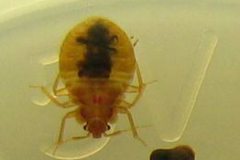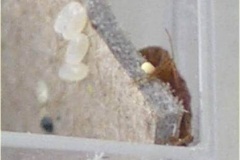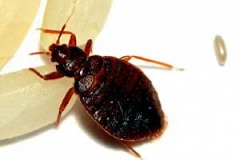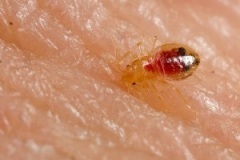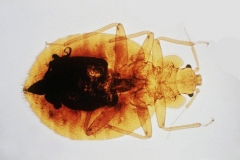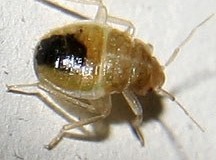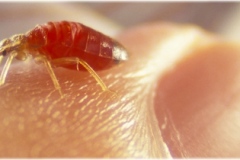Families at Magee Elementary School have rallied to raise money to help three families get their homes treated for bedbugs(Photo: Submitted)
Magee Elementarycommunity members have rallied to help three families raise funds needed to heat treat their homes for bedbugs.
A GoFundMe page for the fundraiser shows that $4,115 has been raised. According to the page, the treatments are costly, typically ranging from $1,500 to more than $4,500, based onthe size of a home.
"It is time for us torally together to support families in our schoolwho have had the misfortune to contract bedbugs into their homes. Eliminating these little pests is difficult to do without professional assistance which is very costly," the GoFundMe page said.
Magee Elementary Principal Sue Sterner said the school learned in October that one of the school's families had an infestation of bed bugs, after a bug was found on a student's coat at the school. Sterner said bedbugs look similar to ticks.
The school also learned that two other families had bedbugs after students made comments to adults in the building.
All told, six students are affected.
The familiesworked on getting their homes treated while procedures were put in place at the school to prevent the spread of bedbugs.Sterner said all the affected families have been communicating with the school about themeasures they have taken to get rid of the bedbugs.
Sterner said she didn't know whether the familieswere connected with each other.
"While I can notify parents that their child has bedbugs or we have these bites or the actual bug, we can't exclude children from school for that. We're a public school. It's not a medical or health crisis. So, similar to head lice, it's a nuisance," Sterner said.
Sterner said that students from the affected homes go straight to the health room when they arrive at school and change into clothing and shoes the school keeps there for them.
The school heat-treatstheir outdoor winter gear so they can go to recess, and laundersthe clothes the students wore to school.
At the end of the school day, the students change back into the clothes and shoes they wore to school.
"We do their laundry here at school just so that we can limit the amount of things that go back and forth between the homes while it's being treated," Sterner said.
"Bedbugs are also different from head lice in that they can feed or bite and then go hide for two, three, eight, 10 months and not come out again until they need to feed. ...That makes bedbugs all the harder to get rid of as well," she added.
The Magee Elementary PTO has bought bins for all students to put their belongings in while they are in school, to keep items separate and prevent the spread of bedbugs.
Other measures included bringing in a pest control company, Batzer, which the school has a regular contract with, and bug-sniffing dogs. To bring the dogs in isaround $250 per visit.Cleaning and vacuuming also takes place in the school every day. Sterner said the school's custodian went above and beyond cleaning the health room at least twice a day and vacuuming common spaces several times a day. The laundry gets done by several people and wasn't an added cost, according to Sterner.
The Magee Elementary principalalso said she sent email updates to parents about what the school was doing to prevent the bugs from spreading.
Sterner said that the school is happy that the fundraiser will help thestudentsreturn to a normal routine.
"They come to school and they're the only ones changing here, and that's hard. I don't want to say it's psychologically (difficult), but it really is,it really isa trauma for kids to deal with what's in their home and then to come here and change their clothes. We really try to make it as private and as painless of an experience as we possibly can," said Sterner.
Sterner said other students are treating the six affected students as they normally would, for the most part.
She said the school iseducating students about bedbugs, that they can be picked up in many different places and not as a result of anything anyone knowingly did.
"We really need to be understanding of families dealing with this in their homes," Sterner said.
Parentsdecided to come together to help after realizing that it wasn't going to be a quick fix, according to Sterner.
Magee Elementary parent Stacy Grafenauerreached out to Sterner to see whether the affected families would be interested in financial assistance, and then organized thefundraiser for the families, who have asked to remain anonymous.
Grafenauer set a goal of $4,000, and hired Milwaukee Bed Bug Pros to administer the treatments toall the affected homes. The money was raised in just four days, from Feb. 7 to 11. Any additional funds that come in willbe used for follow-up treatments. The treatment was scheduled to start the week of Feb. 17.
"I'm very grateful to them (Milwaukee Bed Bug Pros)and to the families in our community that have really stepped up to make this happen," Grafenauersaid.
Sterner said this is an example of the family atmosphere at Magee.
"I think our community has really come together learning more about 'this could happen to anyof us.'People save money for Christmas gifts and they save money for vacations. Nobody saves money for bedbugs, so when and if it happens to you, it is going to be a cost you didn't plan for. I thinkas people realize that, we would hope that we would be able to help each other, should these unforeseen situations arise," said Sterner.
"I've been the principal at Magee this is my fifth year when I started, I heard from people (that) it's a great family atmosphere, it's a small school, they're really tight-knit, lots of traditions and that's truly what it is.
"It could as easily have swung the other way with negative press to ostracizing families, and instead, we've embraced each other, and I think coming out stronger on the other side. This is a great example for our kids as well. Anybody can get them (bedbugs). Doesn't mean they're bad people or anything like that. Look at how we can come together and help people."
ContactAlec Johnson at(262) 875-9469 oralec.johnson@jrn.com. Follow him on Twitter at @AlecJohnson12.
Our subscribers make this reporting possible. Please consider supporting local journalism by subscribing to the Journal Sentinel at jsonline.com/deal.
Autoplay
Show Thumbnails
Show Captions
Read or Share this story: https://www.jsonline.com/story/communities/lake-country/news/oconomowoc/2020/02/18/community-raises-funds-treat-3-families-homes-bedbugs/4760344002/
Read more:
Students at a Lake Country school had bed bugs, here's how the community solving the problem - Milwaukee Journal Sentinel

 Residence
Residence  Location
Location 




